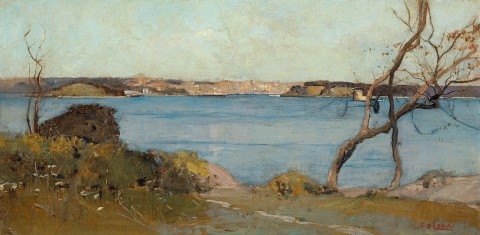SYDNEY HARBOUR FROM CREMORNE POINT, 1909 – 10
SYDNEY LONG
oil on canvas
30.0 x 60.0 cm
signed lower right: Sid Long .
bears inscription verso: SYDNEY HARBOUR BY SYDNEY LONG / Property of Geoffrey Phillip, 79 Werrington Crescent W9
The Rowley Gallery, Kensington Park, London (label attached verso)
Geoffrey Phillip, London
Sotheby’s, London, 4 November 1987, lot 145
James Fairfax AC, New South Wales
Thence by descent
Private collection, Belgium
Sydney Harbour view, 1907, oil on cardboard, 32.0 x 40.0 cm, in the collection of the New England Regional Art Museum, New South Wales
Harbour view, 1908, pencil, watercolour, Chinese white highlights, 31.5 x 29.5 cm, in the collection of the Art Gallery of New South Wales, Sydney
Sydney Long is renowned for his pastoral fantasies Spirit of the plains, 1897 and Pan, 1898 – symbolist masterworks that are amongst the Art Gallery of New South Wales’ most popular paintings. As a gifted student under Julian Ashton, Long shared a studio with George Lambert and was engaged for some years to Thea Proctor until she returned the ring and left for London in 1902. He organised an Art Union in 1905 with Pan as the prize to raise money for overseas travel, but his unscrupulous business partner made off with the funds and many of Long’s paintings, forcing the artist to spend some years painting new works to fulfil his unexpected debts. By 1907, he was almost solvent again and began to work towards fulfilling his ambition of reaching London, and it is plausible that Sydney Harbour from Cremorne Point, 1909 – 10, was one of the last works completed before he left in September 1910.
From its earliest days as a colony, Sydney’s majestic harbour has transfixed artists. William Westall’s paintings from the early 1800s are among the first, and in 1855 Conrad Martens produced a hand-coloured lithograph with a view almost identical to this lot. Before colonisation, the land around Cremorne was called Wulwarrajeung by the Indigenous Cammeraygal people, but Martens’ print was titled Sydney from Robertson's Point, as Cremorne was then known (after James Robertson who was granted land there in 1820). This lithograph is a precisely topographical view which includes the then-levelled rock known as Pinchgut as it appeared before the construction of Fort Denison. The name was changed to Cremorne from 1853 when James Milson purchased the estate and established a pleasure ground based on the renowned Cremorne Gardens in England. Arguably the most famed of the harbour paintings are Arthur Streeton’s panoramas from the 1890s and, more specifically, 1907, emblazoned with his trademark sunshine and blue. By contrast, Sydney Long elicits a less strident response in Sydney Harbour from Cremorne Point, with an almost smoky haze suggestive of mystery and repose.
The headland at Cremorne had been declared public land in 1905 after mining interests had tried to dig there for coal in the 1890s, and Long’s painting may also be interpretated as a celebration of the government’s enlightened decision. The view is taken from near the end of the Point, and Fort Denison can be seen to the right, with Lady Macquarie’s Chair behind it. At the centre, the illuminated bay captures Woolloomooloo in the distance; and to the left, Garden Island as it appeared until the Naval Dock was built during World War Two. Long later wrote that ‘I see it always as a mass of different colours blue, green, violet, grey all blended in that indescribable way that makes up what most people call the blue of the Harbour;’1 and in all respects, this description tallies closely to that of Sydney Harbour from Cremorne Point. As it appears never to have been exhibited, the painting may well have been a private commission; and a possible preparatory watercolour sketch was included in a major loan exhibition of Long’s work held at the Art Gallery of New South Wales in 1941.2
1. Sydney Long, 1926, cited in Grey, A., Sydney Long: spirit of the land, National Gallery of Australia, Canberra, 2012, p. 116
2. Sydney Harbour from Cremorne Point, 1910, watercolour 12” x 9”, Sydney Long, A.R.E.: loan exhibition, National Art Gallery of New South Wales, 9 April – 31 May 1941, cat. 108, ‘lent by H. Cosgrove, Esq.’
ANDREW GAYNOR
